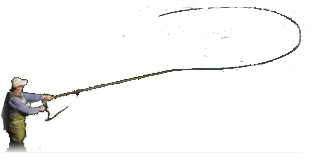Wild Trout from southwestern Wisconsin have quit their spawning by the end of November.
The female lays on her side at the head end of the riffle (right where the water starts to break) and "waps" her tail on the bottom dislodging stones that are carried downstream by the current eventually leaving a bowl shaped depression (redd). When she is ready she will deposit some of her eggs into the bottom of the redd where they will be immediately fertilized by a male. She will immediately go upstream, "wap" her tail on the bottom, again dislodging stones which then bury the deposited eggs in about 3-6 inches of gravel. This will provide some temperature stabilization and insure the eggs have well oxygenated water flowing through them (both upwelling and laminar flow). The female will spawn over several days (sometimes with different males)extending the emergence times for the swim-up fry (insuring better survival).
The eggs will hatch in 50-60 days depending on water temperatures (at 50 degrees it takes about 50 days to hatch). Colder (and warmer) temps will extend the egg development time. If it gets too cold (below 36 degrees) for an extended period of time the eggs will not fully develop before the yolk sac is used up. After the eggs hatch they remain in the gravel for another 3 weeks where they use up the rest of the yolk sac (sac fry) after which they swim up through the gravel (swim-up fry) and start taking their first solid food ( and become fingerlings). If the emergence time is too early (most domestic strain fish), the fry emerge at a time when food production is at a minimum. That's one reason why stocking domestic strain fish rarely leads to natural reproduction. Wild strain fish spawn over a 6-8 week period insuring that at least some fry will emerge at a time when food is plentiful and spring flooding is already done (spring flooding is the limiting factor for good year class recruitment).




 Reply With Quote
Reply With Quote